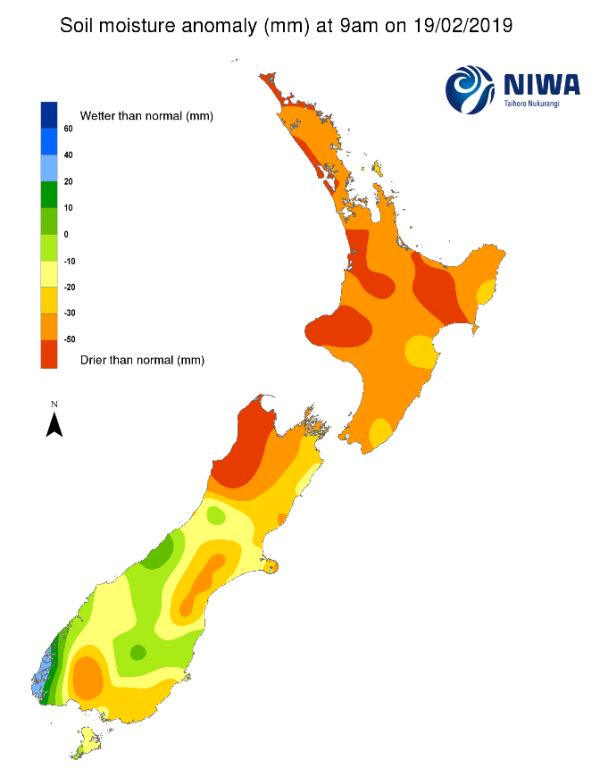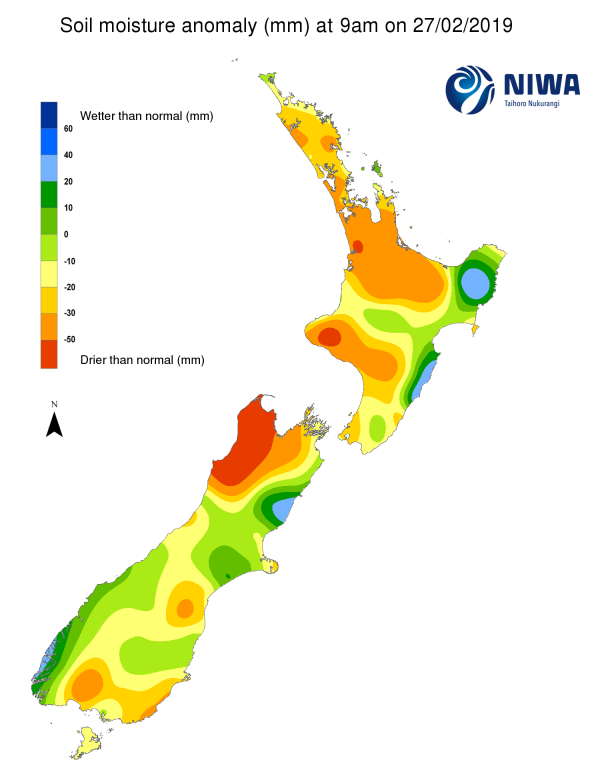A weekly update describing soil moisture across the country to help assess whether severely to extremely dry conditions are occurring or imminent. Regions experiencing these soil moisture deficits are deemed “hotspots”. Persistent hotspot regions have the potential to develop into drought.
Facts: soil moisture
Across the North Island, soil moisture levels improved nearly everywhere due to significant rainfall in the past week. The largest increases were observed in eastern Bay of Plenty, Gisborne, southern Hawke’s Bay along with the Aupouri Peninsula in the Far North. The driest soils across the North Island compared to normal for this time of the year are found in central Taranaki District and parts of western Waikato where the soil moisture levels continue to be well below average for this time of year. The wettest soils for this time of year are found in parts of Opotiki District in Bay of Plenty, Gisborne Region, and coastal Central Hawke’s Bay District.
Areas deemed hotspots have decreased over the past week. Hotspots now encompass parts of western and lower Northland, the Auckland Region, northern and central Waikato, and parts of western Bay of Plenty. In addition, hotspots are also found in South Taranaki District, parts of Manawatu-Wanganui Region along with Wellington.
Across the South Island, soil moisture levels generally increased in eastern areas but remained near constant or slightly decreased in western areas. The driest soils across the South Island compared to normal for this time of the year continue to be found in western Tasman and northern Buller District, while the wettest soils for this time of the year are found around Kaikoura and Hurunui District, along with costal Fiordland.
Areas deemed hotspots have decreased in eastern areas over the past week. Hotspots now encompass parts of northern Tasman, Buller District, Nelson and western and central Marlborough. Hotspots are also found in eastern Banks Peninsula, south-central Canterbury, coastal southern Otago and small portions of Southland.
Outlook and soil moisture
In the North Island, mostly tranquil weather and rainfall well below normal is expected in the upcoming week with high pressure in control. A period of mostly, if not completely dry conditions is expected with only a few passing showers possible, mainly in eastern areas.
Total weekly rainfall will likely be minimal (below 5 mm) for the majority of the island. However, Gisborne and the lower east coast may see rainfall totals of 5-10 mm in the upcoming week. Due to the meagre rainfall anticipated, soil moisture levels are expected to decrease everywhere in the next week. This will likely lead to an expansion of all hotspots across the island.
For the South Island, rainfall below normal is expected as well. A weak front may bring 5-10 mm of rain to the lower and western South Island on Tuesday and Wednesday (5-6 March), with the potential for higher rainfall totals in costal Fiordland. Weekly rainfall is expected to be minimal (below 5 mm) in interior, eastern and northern areas, while southern and western areas may see rainfall totals of 5-10 mm. Far coastal Fiordland is the only region where significant rainfall (above 50 mm) is possible. Due to the low rainfall amounts expected, all of the current hotspots will likely intensify and expand in the upcoming week.
Background
Hotspot Watch: a weekly advisory service for New Zealand media. It provides soil moisture and precipitation measurements around the country to help assess whether extremely dry conditions are imminent.
Soil moisture deficit: the amount of water needed to bring the soil moisture content back to field capacity, which is the maximum amount of water the soil can hold.
Soil moisture anomaly: the difference between the historical normal soil moisture deficit (or surplus) for a given time of year and actual soil moisture deficits.
Definitions: “Extremely” and “severely” dry soils are based on a combination of the current soil moisture status and the difference from normal soil moisture. See soil moisture maps.
Hotspot: A hotspot is declared if soils are "severely drier than normal" which occurs when Soil Moisture Deficit (SMD) is less than -110 mm AND the Soil Moisture Anomaly is less than -20 mm.



